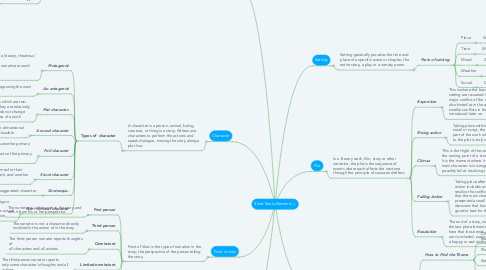
1. Conflict
1.1. What is conflict?
1.1.1. The conflict consists of expressing the resistance, difficulty, or dilemma in which the protagonist of the story finds himself while trying to achieve his goals or dreams.
1.1.1.1. Types of conflicts
1.1.1.1.1. External conflict
1.1.1.1.2. Internal conflict
1.1.1.1.3. Sub-conflict types
2. Character
2.1. A character is a person, animal, being, creature, or thing in a story. Writers use characters to perform the actions and speak dialogue, moving the story along a plot line.
2.1.1. Types of character
2.1.1.1. Protagonist
2.1.1.1.1. Is the main character of a literary, theatrical, cinematic video game, or musical narrative around whom the events of the narrative’s plot revolve
2.1.1.2. An antagonist
2.1.1.2.1. Is a character or force opposing the main character.
2.1.1.3. Flat character.
2.1.1.3.1. There are characters which are two- dimensional in that they are relatively uncomplicated and do not change throughout the course of a work
2.1.1.4. A round character
2.1.1.4.1. Is fully developed & three-dimensional character that is utterly plausible
2.1.1.5. Foil character
2.1.1.5.1. Serves as a contrast to another primary character so as to point out specific traits of the primary character.
2.1.1.6. Stock character
2.1.1.6.1. Rely on cultural types or names for their personality, manner of speech, and another characteristics.
2.1.1.7. Grotesque.
2.1.1.7.1. An exaggerated character
2.1.1.8. Non- fictional character
2.1.1.8.1. Is a character that is a real-life figure whether played by an actor or used as an actual historical figure in a work of fiction.
3. Point of view
3.1. Point of View is the type of narration in the story; the perspective of the person telling the story.
3.1.1. First person
3.1.1.1. The narrator is a character in the story and tells it from his or her perspective.
3.1.2. Third person
3.1.2.1. The narrator is not a character directly involved in the action of in the story.
3.1.3. Omniscient
3.1.3.1. The third person narrator reports thoughts of all characters and all actions.
3.1.4. Limited omniscient
3.1.4.1. The third person narrator reports only some character's thoughts and all actions.
3.1.5. Objective, Effaced
3.1.5.1. The third person narrator reports no thoughts of characters. The narrator reports only actions and dialog.
4. Resources
4.1. Ebong, I. (s. f.). BASIC ELEMENTS OF DRAMA. Penroll Corporation. BASIC ELEMENTS OF DRAMA
4.2. Point of View. (2019, 10 marzo). Literary Terms. Point of View: Definitions and Examples | Literary Terms
4.3. Lumen Learning. (s. f.). Elements of a Short Story | English Composition 2. lumenlearni. Elements of a Short Story | English Composition 2
5. Setting
5.1. Setting generally provides the time and place of a specific scene or chapter, the entire story, a play or a narraty poem.
5.1.1. Parts of setting
5.1.1.1. Place
5.1.1.1.1. Where the story takes place.
5.1.1.2. Time
5.1.1.2.1. When the story takes place.
5.1.1.3. Mood
5.1.1.3.1. Atmosphere, surroundings.
5.1.1.4. Weather
5.1.1.4.1. Climate, precipitation = mood
5.1.1.5. Social
5.1.1.5.1. Dress, language, religion, culture.
6. Plot
6.1. In a literary work, film, story or other narrative, the plot is the sequence of events where each affects the next one through the principle of cause-and-effect.
6.1.1. Exposition
6.1.1.1. This is where the basic characters and setting are revealed. In most cases the major conflict of the story, novel or script is also hinted at in the exposition, though smaller conflicts in the plot may be introduced later on.
6.1.1.1.1. Beginning of the story that introduces.
6.1.2. Rising action
6.1.2.1. Taking place within the first third of a story, novel or script, the rising action is also the part of the work where the conflict central to the plot is truly introduce
6.1.2.1.1. Events before the climax; characters attend to solve the problem; but fails.
6.1.3. Climax
6.1.3.1. This is the Hight of the story. The climax is the turning point of a story, novel or script. It is the moment where it seems like the main character is in danger or could even possibly fail at resolving the conflict.
6.1.3.1.1. The turning point; the point of greatest suspense or action.
6.1.4. Falling Action
6.1.4.1. Taking place after the climax, the falling action includes events that will help to fully resolve the conflict. The results of actions that the main character has taken are presented as well as the results of decisions that have been made, whether good or bad for the character.
6.1.5. Resolution
6.1.5.1. The end of a story, novel or script includes the last plot element the resolution. It is here that loose ends are tied up, conflicts are concluded, outcomes are revealed, and a happy or sad ending takes pla
6.1.5.1.1. End of the story where the conflicts or problems are solved.
7. Theme
7.1. A theme is the message an author is trying to deliver to the reader through his or her writing.
7.1.1. How to Find the Theme
7.1.1.1. Characters - The people who take part in the action of the story
7.1.1.2. Plot - The events that make up a story
7.1.1.3. Setting - Where the story takes place
7.1.1.4. Conflict - The struggle faced by the main character that must reach a resolution
7.1.2. Common Theme Examples
7.1.2.1. Compassion
7.1.2.2. Courage
7.1.2.3. Death and dying
7.1.2.4. Honesty
7.1.2.5. Loyalty

